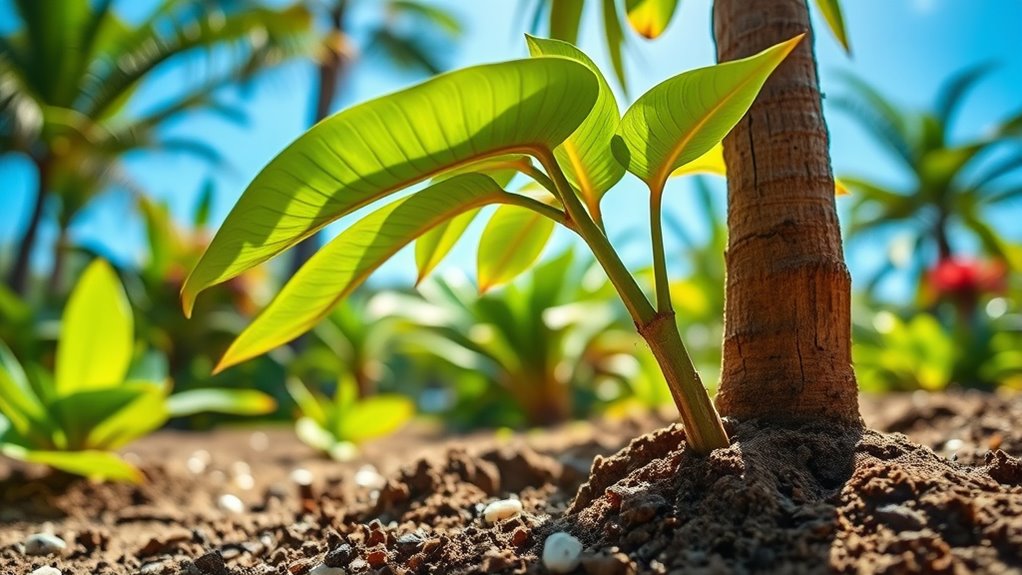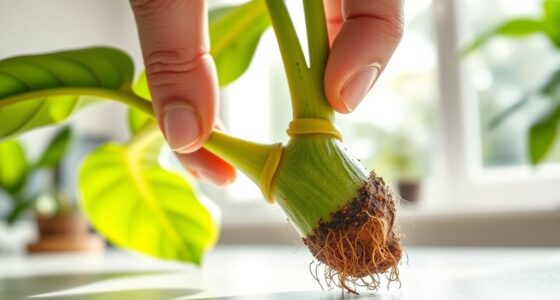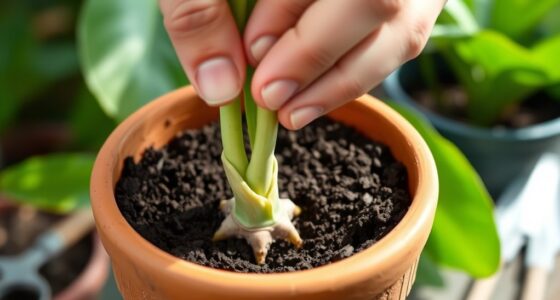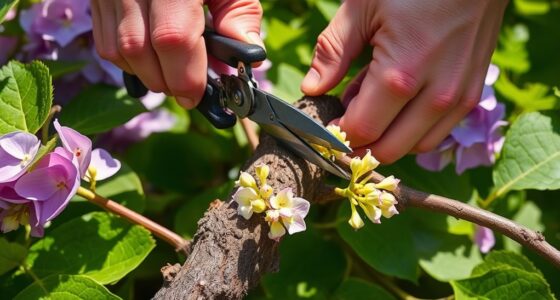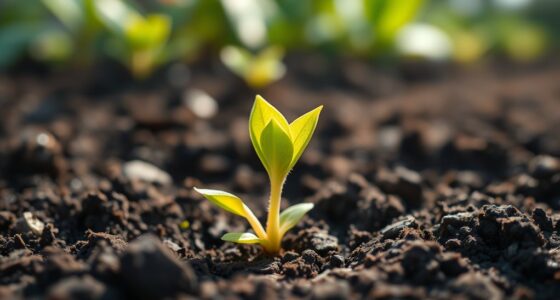To plant plumeria for lush tropical blooms, choose a sunny spot with at least six hours of direct sunlight daily and good air circulation. Use well-draining soil enriched with organic matter, and plant at the correct depth, making sure the top of the root ball is slightly above ground. Water deeply but infrequently, fertilize regularly, and prune to shape the plant. For more tips on thriving plumeria, keep exploring further steps to ensure vibrant, abundant blooms.
Key Takeaways
- Choose a sunny, well-ventilated spot with well-draining soil and amend with organic matter for optimal growth.
- Plant in a location with at least 6 hours of direct sunlight daily to promote vibrant blooms.
- Ensure proper soil pH (6.0–7.0) and incorporate organic fertilizers like compost to enrich nutrients.
- Water deeply but infrequently, allowing the soil to dry between watering to prevent root rot.
- Regularly prune and maintain the plant to encourage healthy growth and abundant, lush blooms.
Selecting the Ideal Location for Your Plumeria
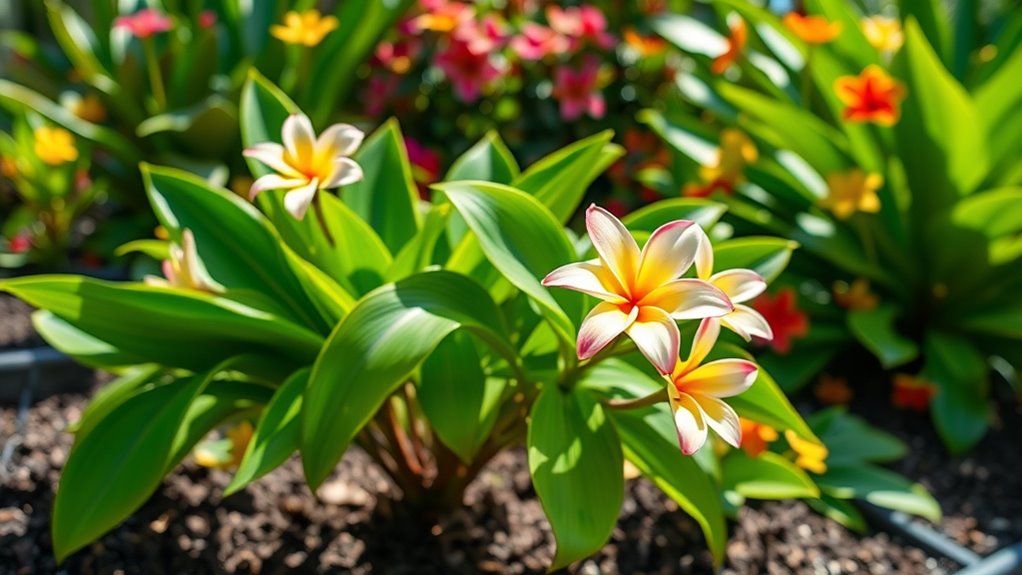
Choosing the right location is crucial for your plumeria to thrive. You want to find a spot with plenty of sunlight, as plumerias prefer full sun for maximum blooming. Aim for at least six hours of direct sunlight daily, avoiding shaded areas that stunt growth. Consider pest prevention strategies by choosing a well-ventilated location to minimize humidity and discourage pests like aphids and spider mites. Keep your plumeria away from dense foliage or crowded spots where pests can hide and spread. A sunny, open area not only encourages vibrant flowers but also reduces the risk of pests taking hold. Proper placement ensures your plumeria will flourish with healthy growth and abundant blossoms. Additionally, ensure good lighting by combining ambient, task, and accent lighting for a cozy feel. Maintaining appropriate air circulation around your plant is also essential to prevent fungal issues and promote healthy growth. Proper soil drainage is equally important to prevent root rot and maintain plant health.
Preparing the Soil for Healthy Growth
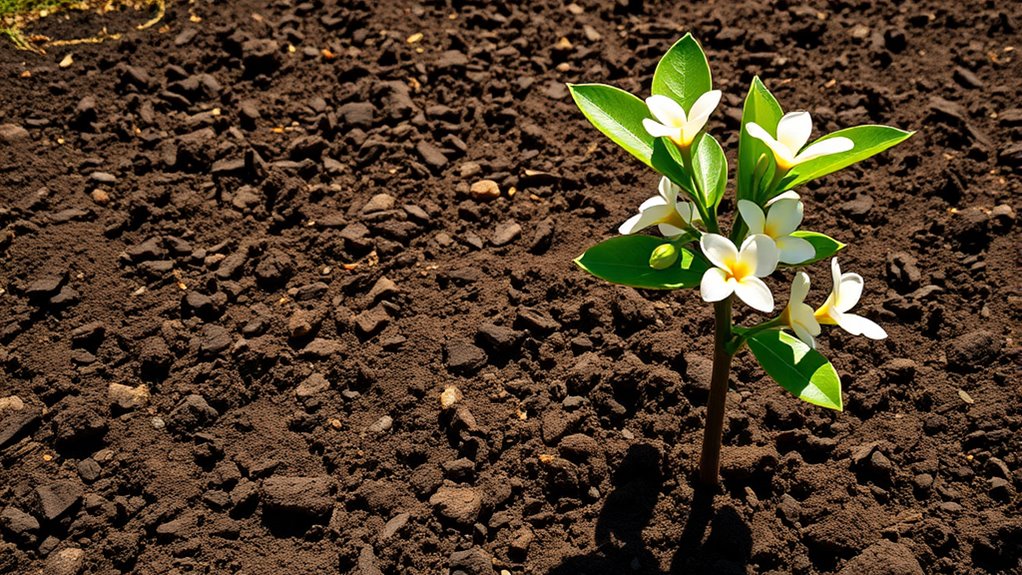
To guarantee your plumeria thrives, start by checking that the soil drains well to prevent waterlogging. Adjust the pH level if needed to keep it slightly acidic to neutral, which promotes healthy growth. Enrich the soil with organic nutrients to give your plant the best start. Incorporating soil management techniques can further enhance your plant’s chances of success. Additionally, understanding the importance of fathers’ influence can inspire you to nurture your plant with the same care and dedication.
Soil Drainage Essentials
Ensuring proper soil drainage is essential for the healthy growth of plumeria. The right soil composition helps prevent water from pooling around roots, which can cause rot. To achieve this, you should use a well-draining mix that includes materials like sand, perlite, or pumice. These additives improve drainage systems and create air pockets, promoting healthy root development. Avoid dense, clay-heavy soils that retain too much moisture. If your soil doesn’t drain well naturally, consider planting your plumeria in a raised bed or container with drainage holes. Regularly check drainage during watering to ensure excess water flows freely away from the roots. Efficient irrigation practices are also important to maintain optimal moisture levels. Proper soil drainage sets the foundation for vibrant, lush blooms and a thriving plumeria. Online platforms facilitate the exposure of marital betrayals, highlighting the importance of trust and honesty in relationships.
Ph Level Optimization
Optimizing the pH level of your soil is essential for plumeria’s nutrient absorption and overall health. Soil acidity directly impacts how well your plant can access vital nutrients, so pH testing is a crucial step. Test your soil’s pH regularly using a reliable testing kit to determine if adjustments are needed. Plumeria thrives in slightly acidic to neutral soil, with a pH between 6.0 and 7.0. If your soil is too acidic (below 6.0), incorporate lime to raise the pH. Conversely, if it’s too alkaline (above 7.0), add sulfur or organic matter like compost to lower it. Maintaining the proper pH ensures your plumeria roots can absorb nutrients effectively, promoting lush growth and vibrant blooms. Soil testing is a valuable tool to monitor and maintain optimal conditions for healthy growth.
Nutrient Enrichment Tips
Preparing your soil with the right nutrients is key to supporting healthy plumeria growth. To do this, incorporate soil amendments like compost or well-rotted organic matter to improve drainage and nutrient content. Organic fertilizers, such as fish emulsion or compost tea, provide essential nutrients without chemical buildup. Before planting, mix these amendments into the soil thoroughly, ensuring even distribution. This creates a nutrient-rich environment that encourages strong root development and vibrant blooms. Regular feeding with organic fertilizers during the growing season boosts plant health and flowering. Avoid over-fertilizing, which can cause excessive foliage at the expense of flowers. By enriching your soil with these natural options, you set the stage for lush, tropical plumeria blooms. Additionally, understanding the importance of sustainable gardening practices can help maintain healthy soil and plants over time. Incorporating proper soil management techniques ensures long-term plant vitality and optimal flowering.
Choosing the Right Plumeria Plant or Cuttings
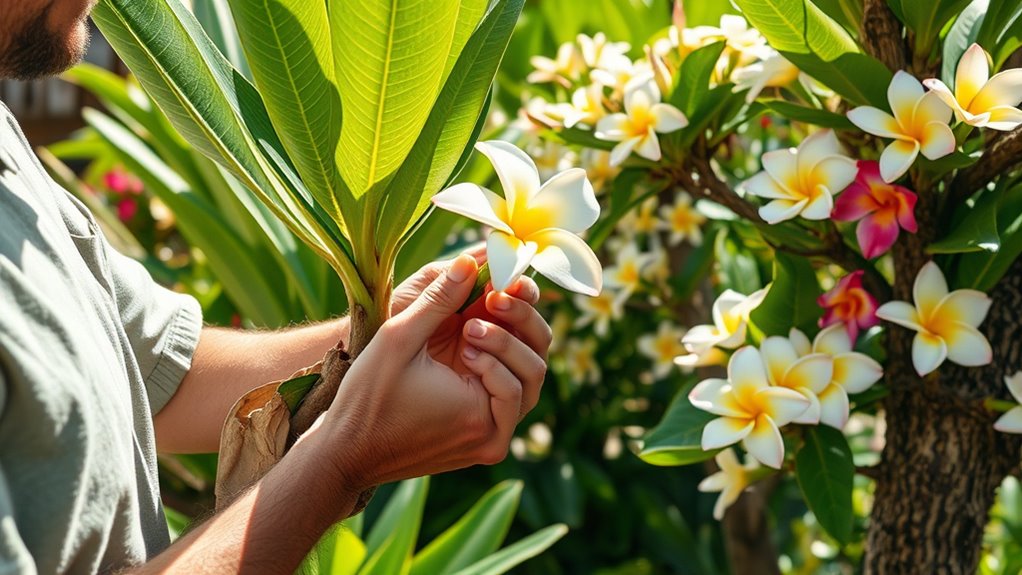
When selecting a plumeria plant or cuttings, it’s important to choose healthy, disease-free specimens that show vibrant foliage and strong stems. Start by choosing cultivars known for their lush blooms and adaptability to your climate. If rooting cuttings, pick healthy, well-developed stems with no signs of disease or pests. Look for cuttings that are at least 12 inches long, with a few leaf nodes. Avoid those with soft, rotting, or damaged sections. When choosing cultivars, consider color, fragrance, and growth habits to match your preferences. Properly selected plants and cuttings set the foundation for successful rooting and vibrant blooms. Always inspect for healthy roots or stem segments to ensure your plumeria will thrive in its new environment. Additionally, understanding AI security measures in plant research can help protect valuable cultivars from digital threats.
Planting Your Plumeria Properly
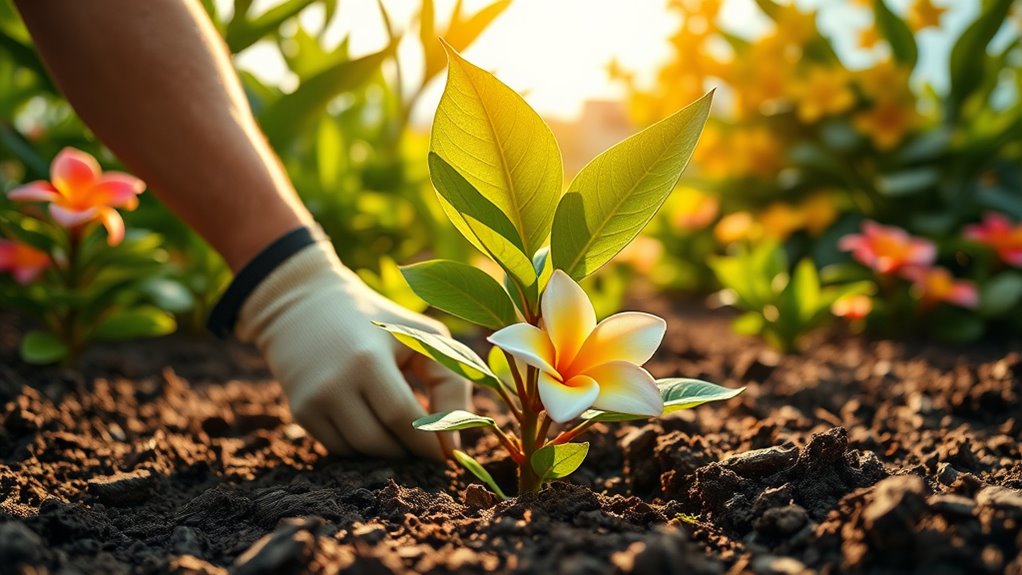
Have you chosen the right location for planting your plumeria? Ensure it gets plenty of sunlight—at least six hours daily—to promote vibrant leaf coloration and healthy growth. Select well-draining soil to prevent root rot, and plant your plumeria at the right depth, with the top of the root ball slightly above ground level. Proper planting helps your plant establish quickly and reduces pest issues by minimizing standing water and overly moist conditions. Keep an eye out for early signs of pests like aphids or scale; healthy, vigorous plants are less prone to infestations. Additionally, understanding symptoms of pests and diseases can help you address issues early and maintain a healthy, thriving plant. Being aware of plant care requirements can further ensure your plumeria receives optimal conditions for lush blooms and robust growth. Proper placement and soil management are key to thriving, tropical beauty, and using appropriate fertilization can support ongoing vitality and flowering. By planting your plumeria correctly, you set a strong foundation for lush blooms and minimize problems that could hinder its growth.
Watering and Fertilizing for Vibrant Blooms
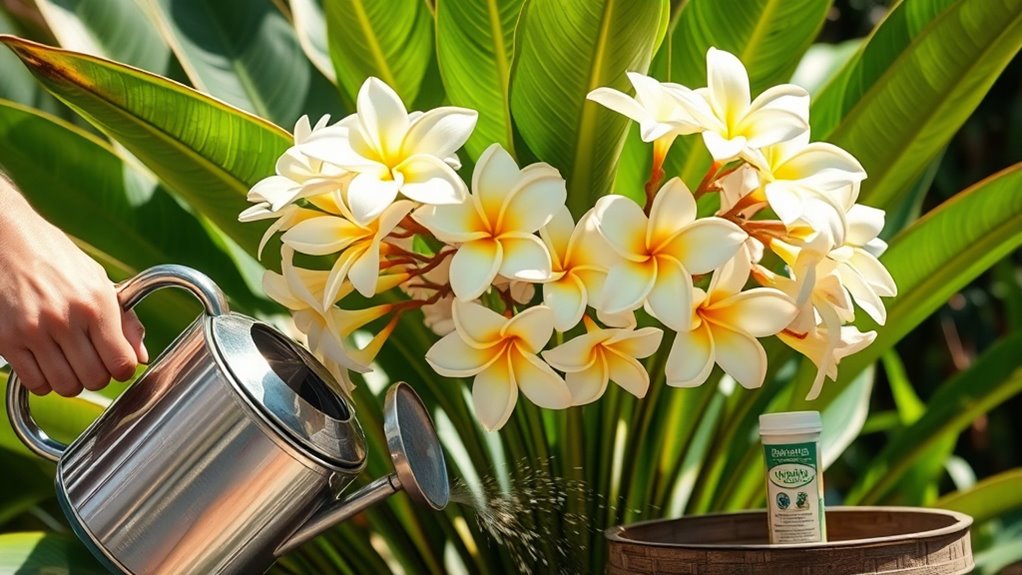
To guarantee your plumeria produces vibrant blooms, you need to establish a proper watering and fertilizing routine. Water your plumeria deeply when the top inch of soil feels dry, avoiding overwatering that can lead to root rot. Use a balanced, slow-release fertilizer every month during the growing season to promote healthy flowering. Regular pest control is essential—inspect leaves for pests like aphids or mealybugs, and treat promptly. Pruning techniques also help direct energy toward blooms; remove dead or crowded branches to improve airflow and sunlight exposure. Proper watering, fertilizing, and pest management, combined with strategic pruning, will ensure your plumeria thrives with lush, vibrant blossoms throughout the season. Additionally, incorporating sound vibrations through gentle music or sound therapy can enhance plant health and encourage blooming. Recognizing the importance of Kia Tuning concepts such as suspension and airflow can also inspire creative ways to optimize your garden environment for better plant growth, ensuring optimal nutrient absorption and overall vitality.
Caring for Your Plumeria to Ensure Longevity and Beauty
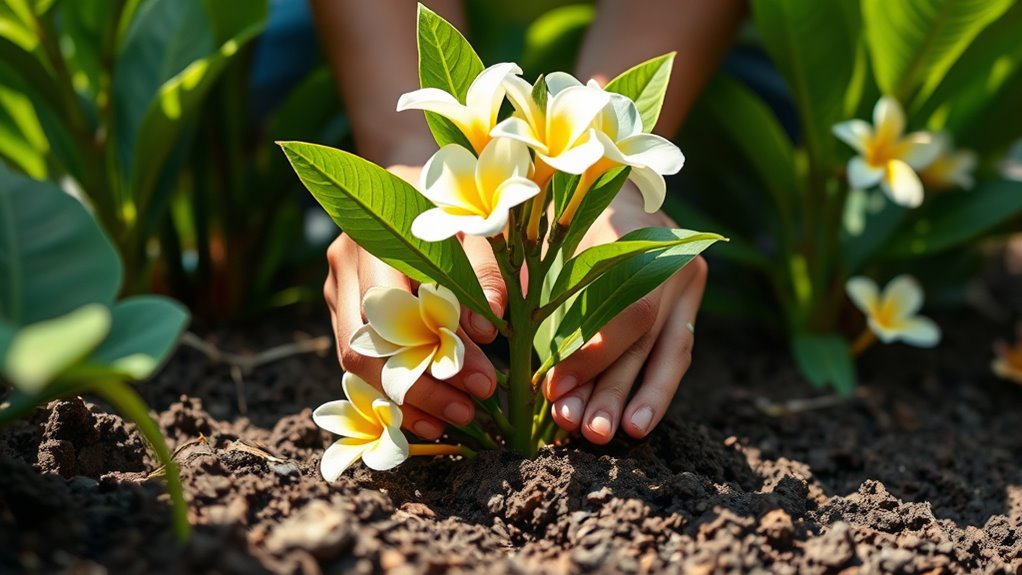
To keep your plumeria healthy and beautiful, you need to pay attention to watering and drainage, making sure the soil doesn’t stay soggy. Establishing a consistent fertilizing schedule will promote vibrant blooms and strong growth. Additionally, proper pruning techniques help maintain the plant’s shape and encourage new, healthy branches. Monitoring soil moisture levels is essential to prevent overwatering and root rot.
Watering and Drainage
Proper watering and drainage are essential for keeping your plumeria healthy and vibrant. Overwatering can cause root rot, while poor drainage leads to waterlogged soil. To guarantee excellent health, follow these watering tips and drainage solutions:
- Water deeply, but infrequently—allow the soil to dry out between watering sessions.
- Use well-draining soil or amend your planting mix with sand or perlite to improve drainage.
- Elevate your pot or ensure your garden bed has proper drainage to prevent standing water.
- Remember that proper sealing mechanisms in containers can also help maintain consistent internal conditions, supporting healthy growth.
Monitoring soil moisture regularly helps prevent overwatering, and adjusting your watering schedule accordingly keeps your plumeria thriving. Good drainage is key to avoiding root issues and encouraging lush, tropical blooms.
Fertilizing Schedule
A well-planned fertilizing schedule supports your plumeria’s growth and keeps it vibrant throughout the season. Apply compost regularly to provide essential nutrients and improve soil health. Use a balanced fertilizer with a higher phosphorus content to promote blooms, applying it every 4 to 6 weeks during the active growing season. Avoid over-fertilizing, as this can lead to lush foliage but fewer flowers. Incorporate pest management practices alongside fertilization—healthy plants are more resistant to pests. Keep an eye out for common issues like aphids or mealybugs, and address them promptly to prevent damage. Consistent fertilizing combined with good pest management ensures your plumeria remains healthy, blooms profusely, and maintains its lush, tropical appearance.
Pruning Techniques
Regular pruning is essential for maintaining your plumeria’s health and enhancing its natural beauty. Proper pruning techniques encourage new growth and abundant blooms. First, always use sharp pruning tools to make clean cuts that minimize damage. Second, prune in early spring before active growth begins, removing dead or diseased branches. Finally, shape the plant by trimming back overgrown stems, focusing on maintaining a balanced structure. Be careful not to over-prune, as this can stress the plant. Remove any crossing or inward-growing branches to improve airflow and overall health. With these pruning techniques, your plumeria will stay vigorous, healthy, and ready to burst into lush, tropical blooms season after season.
Frequently Asked Questions
How Long Does It Take for Plumeria to Flower After Planting?
After planting, you can expect the flowering timeline to vary, typically taking 1 to 2 years for your plumeria to bloom. During this period, it goes through key growth stages, like establishing roots and developing healthy branches. Keep in mind, proper care accelerates flowering, so make certain it gets plenty of sunlight, well-draining soil, and regular watering. Patience is key; with good care, your plumeria will reward you with lush, tropical blooms.
Can Plumeria Grow Indoors Successfully?
Growing plumeria indoors is like trying to capture a piece of the tropics inside your home. You can succeed by providing plenty of indoor sunlight—aim for a south-facing window. Make sure your container has good drainage to prevent root rot, and keep the plant in a warm, humid environment. With proper care, your indoor plumeria will thrive and even bloom, adding a splash of tropical beauty to your space.
What Pests Commonly Affect Plumeria Plants?
You should regularly check your plumeria for pests like spider mites, mealybugs, and aphids. Proper pest identification helps you target the issue effectively. If you notice infestations, use natural remedies such as neem oil or insecticidal soap to control pests without harming your plant. Staying vigilant and acting promptly keeps your plumeria healthy, ensuring it continues to produce those lush, tropical blooms you desire.
How Do I Overwinter My Plumeria in Colder Climates?
Imagine the warmth of summer fading, yet your plumeria’s vibrant blooms can survive. To overwinter in colder climates, you need winter protection. Move your plant to a container for easy overwintering indoors, where it can bask in bright, indirect light. Keep temperatures between 50-60°F, and reduce watering. This container overwintering method keeps your plumeria alive and ready to thrive again when spring arrives.
Is It Necessary to Prune Plumeria Regularly for Optimal Blooms?
Pruning benefits your plumeria by encouraging healthy growth and vibrant blooms. Regular pruning helps remove dead or crowded branches, which promotes better airflow and flowering encouragement. You should prune in early spring or after blooming to shape the plant and stimulate new growth. Keep your cuts clean and sharp, and don’t be afraid to prune lightly—this practice guarantees your plumeria produces lush, tropical flowers throughout the season.
Conclusion
With a little care, your plumeria will flourish like a burst of sunshine, its fragrant blooms dancing in the warm breeze. Imagine vibrant petals opening to reveal a splash of tropical color, filling your space with a sweet, intoxicating scent. As you nurture it with patience and love, your plumeria becomes a lush centerpiece, transforming your garden into a paradise of endless summer. Keep tending, and watch your tropical dream bloom into breathtaking reality.
